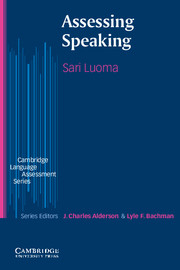8 - Ensuring a reliable and valid speaking assessment
Published online by Cambridge University Press: 03 May 2010
Summary
From a testing perspective, speaking is special because of its interactive nature. It is often tested in live interaction, where the test discourse is not entirely predictable, just as no two conversations are ever exactly the same even if they are about the same topic and the speakers have the same roles and aims. There is also some variability in the rating process because it involves human raters. This means that special procedures are needed to ensure the reliability and validity of the scores. In this chapter, I will provide an overview of these procedures. This topic closes the cycle of speaking assessment, and in the course of the discussion I will revisit some of the main themes of this book. I will conclude the chapter with a look forward into future developments in speaking assessment.
The importance of rating in the speaking assessment cycle
The development and use of speaking tests is a cyclical process. It starts from a need for speaking scores and finishes with the use of the scores for this purpose. In between, there is a test development process and a two step testing process, where the test is first administered and then scored. The administration is an interaction between the examinees and interlocutors or other examinees to complete the tasks, and it produces the test discourse. The rating is an interaction between the raters, the criteria and the performances included in the test discourse to produce the scores.
- Type
- Chapter
- Information
- Assessing Speaking , pp. 170 - 191Publisher: Cambridge University PressPrint publication year: 2004



